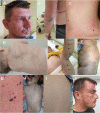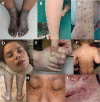Skin Conditions and Movement Disorders: Hiding in Plain Sight
- PMID: 35844274
- PMCID: PMC9274368
- DOI: 10.1002/mdc3.13436
Skin Conditions and Movement Disorders: Hiding in Plain Sight
Abstract
Skin manifestations are well-recognized non-motor symptoms of Parkinson's disease (PD) and other hypokinetic and hyperkinetic movement disorders. Skin conditions are usually well visible during routine clinical examination and their recognition may play a major role in diagnostic work-up. In this educational review we: (1) briefly outline skin conditions related to Parkinson's disease, including therapy-related skin complications and their management; (2) discuss the role of skin biopsies in early diagnosis of PD and differential diagnosis of parkinsonian syndromes; and focus more on areas which have not been reviewed in the literature before, including (3) skin conditions related to atypical parkinsonism, and (4) skin conditions related to hyperkinetic movement disorders. In case of rare hyperkinetic movement disorders, specific dermatological manifestations, like presence of angiokeratomas, telangiectasias, Mongolian spots, lipomas, ichthyosis, progeroid skin changes and others may point to a very specific group of disorders and help guide further investigations.
Keywords: atypical parkinsonism; hyperkinetic; movement disorders; skin; skin biopsy.
© 2022 International Parkinson and Movement Disorder Society.
Conflict of interest statement
This work was supported by the Operational Programme Integrated Infrastructure, funded by the ERDF under No. ITMS2014+:313011 V455 for KK, JB and MS. The authors declare that there are no conflicts of interest relevant to this work.
Figures



Similar articles
-
Chapter 33: the history of movement disorders.Handb Clin Neurol. 2010;95:501-46. doi: 10.1016/S0072-9752(08)02133-7. Handb Clin Neurol. 2010. PMID: 19892136 Review.
-
Parkinson's disease or atypical parkinsonism? The importance of acoustic voice analysis in differential diagnosis of speech disorders.Brain Behav. 2020 Aug;10(8):e01700. doi: 10.1002/brb3.1700. Epub 2020 Jun 11. Brain Behav. 2020. PMID: 32525283 Free PMC article.
-
Neuropathology and pathogenesis of extrapyramidal movement disorders: a critical update-I. Hypokinetic-rigid movement disorders.J Neural Transm (Vienna). 2019 Aug;126(8):933-995. doi: 10.1007/s00702-019-02028-6. Epub 2019 Jun 18. J Neural Transm (Vienna). 2019. PMID: 31214855 Review.
-
EFNS/MDS-ES/ENS [corrected] recommendations for the diagnosis of Parkinson's disease.Eur J Neurol. 2013 Jan;20(1):16-34. doi: 10.1111/ene.12022. Eur J Neurol. 2013. PMID: 23279440 Review.
-
C9ORF72 intermediate repeat expansion in patients affected by atypical parkinsonian syndromes or Parkinson's disease complicated by psychosis or dementia in a Sardinian population.J Neurol. 2015 Nov;262(11):2498-503. doi: 10.1007/s00415-015-7873-6. Epub 2015 Aug 15. J Neurol. 2015. PMID: 26275564
Cited by
-
Redefining Autoimmune Disorders' Pathoetiology: Implications for Mood and Psychotic Disorders' Association with Neurodegenerative and Classical Autoimmune Disorders.Cells. 2023 Apr 25;12(9):1237. doi: 10.3390/cells12091237. Cells. 2023. PMID: 37174637 Free PMC article. Review.
-
Long-term outcomes in two adult siblings with Fucosidosis - Diagnostic odyssey and clinical manifestations.Mol Genet Metab Rep. 2023 Sep 27;37:101009. doi: 10.1016/j.ymgmr.2023.101009. eCollection 2023 Dec. Mol Genet Metab Rep. 2023. PMID: 38053939 Free PMC article.
-
Complications associated with intestinal infusion therapies in patients with Parkinson's disease: a single-center retrospective study and 15-year experience.Front Neurol. 2025 May 14;16:1547557. doi: 10.3389/fneur.2025.1547557. eCollection 2025. Front Neurol. 2025. PMID: 40438578 Free PMC article.
-
Movement disorders associated with diarrhoea.J Neural Transm (Vienna). 2025 Jul 17. doi: 10.1007/s00702-025-02924-0. Online ahead of print. J Neural Transm (Vienna). 2025. PMID: 40676287 Review.
References
-
- Niemann N, Billnitzer A, Jankovic J. Parkinson's disease and skin. Parkinsonism Relat Disord 2021;82:61–76. - PubMed
-
- Berkovic SF, Andermann F, Shoubridge EA, et al. Mitochondrial dysfunction in multiple symmetrical lipomatosis. Ann Neurol 1991;29:566–569. - PubMed
-
- Mohrenschlager M, Braun‐Falco M, Ring J, Abeck D. Fabry Disease: Recognition and management of cutaneous manifestations. Am J Clin Dermatol 2003;4:189–196. - PubMed
Publication types
LinkOut - more resources
Full Text Sources

